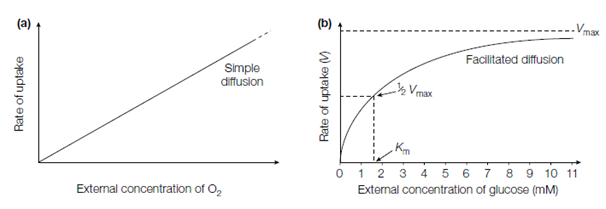Facilitated diffusion
Not like simple diffusion the facilitated or carrier-mediated diffusion of a molecule across a biological membrane is dependent on specific integral membrane

Figure: Kinetics of (a) simple and (b) facilitated diffusion
proteins, frequently known as uniporters. The molecule binds to the protein on one side of the membrane and the protein then undergoes a conformational modified, transports the molecule across the membrane and then releases it on the other side. The Molecules transported across membranes in this way involve hydrophilic molecules like as glucose, other amino acids and sugars. The transport proteins are specific for one particular molecule or a set of structurally same molecules. The transport proteins are capable of being saturated to display Michaelis–Menten-type binding kinetics (Km and Vmax), and are infiuenced through temperature, inhibitor and pH molecules in a same manner to enzymes.
An instance of facilitated diffusion is the uptake of glucose into erythrocytes through the glucose transporter. Erythrocyte glucose transporter is an integral membrane protein of mass 45 kDa which is asymmetrically orientated in the plasma membrane. That uniporter protein structure traverses the membrane with 12 α-helices that form a central pore by that the glucose molecule is passed upon conformational modifies in the protein that is shown in the above figure. All the steps in the transport of glucose into the cell are freely reversible the way of movement of glucose being dictated through the relative concentrations of glucose on either side of the membrane. In the order to maintain the concentration gradient across the membrane the glucose is rapidly phosphorylated inside the cell through hexokinase to glucose 6-phosphate that is no longer a substrate for the glucose transporter.
Erythrocyte glucose transporter is highly specific for D-glucose or Km 1.5 mM, the nonbiological L-isomer being transported at a barely measurable rate. D- galactose and D-Mannose, that differ from D-glucose in the configuration at one carbon atom are transported at intermediate rates. Therefore the transporter has a higher affinity lower Km for glucose than for other sugars.Several cells, like as erythrocytes and those in the kidney, hold water-channel proteins, aquaporins, which accelerate the osmotic fiow of water. Every aquaporin protein is a tetramer of identical 28 kDa subunits by each subunit containing six transmembrane α-helices. The water molecules move by a central pore in every subunit. Aquaporins allow cells to move large quantities of water rapidly across their plasma membrane.